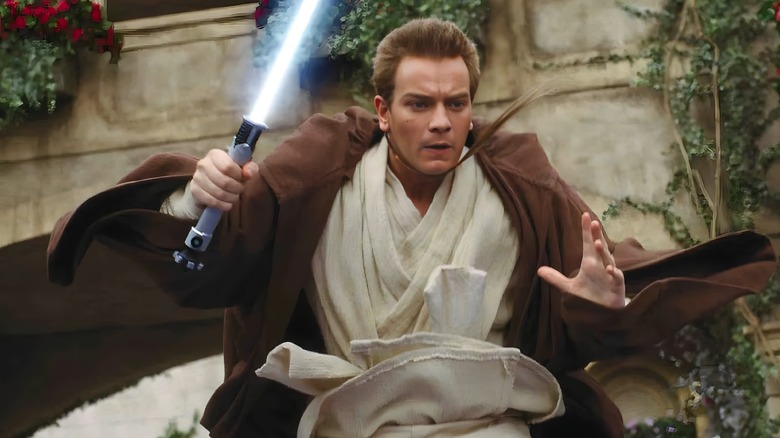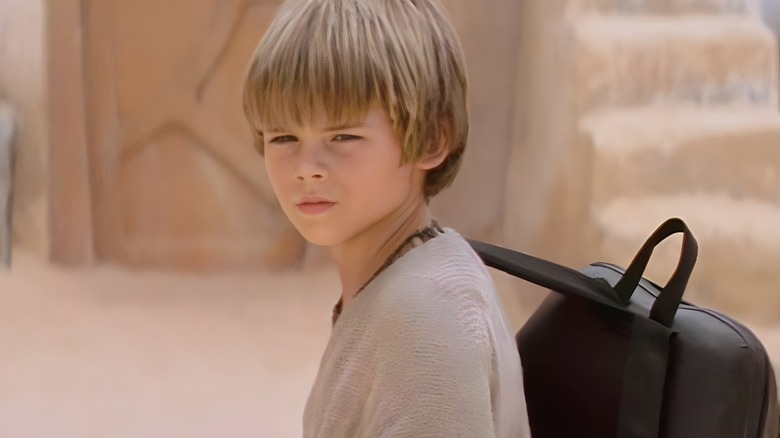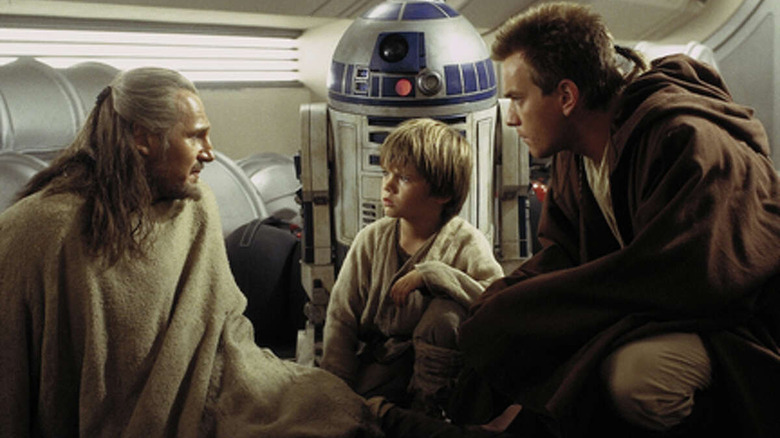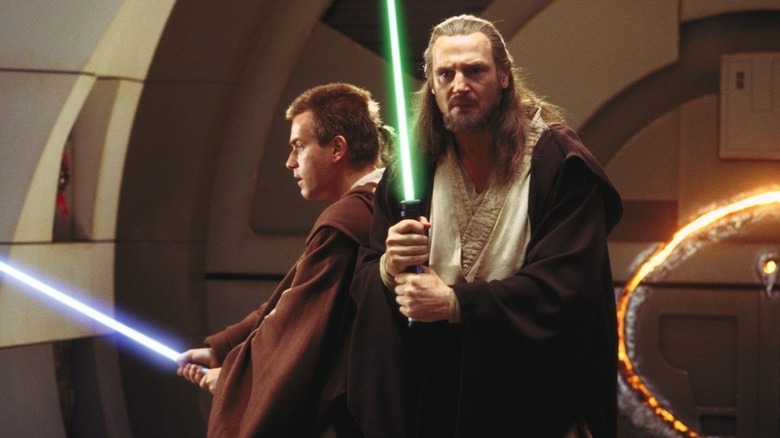Star Wars: The Phantom Menace Owes Its Existence To Young Indiana Jones
Telling tales of adventure heroes when they were younger is hardly a new idea. The teenage version of Superman, called Superboy, was introduced in 1945 and shows like "Smallville," "Krypton," and "Gotham" explore the early days of a superhero's life. "Butch and Sundance: The Early Days" was released in 1979. The 1980s saw any number of Saturday morning cartoons that featured kid versions of, say, the Flintstones, the Scooby-Doo gang, or the Muppets. Other examples of this phenomenon include "Yo Yogi!," "Baby Looney Tunes," Gregory Maguire's book "Wicked," "Dumb and Dumber: When Harry Met Lloyd," "Young Hercules," "Young Sherlock Holmes," and "Young Sheldon."
And of course, there was the 1992 TV series "The Young Indiana Jones Chronicles," an adventure series about the title character as he was at age 10 (Corey Carrier) and 16 (Sean Patrick Flanery). The series was bookended by intro segments with a 93-year-old Indy (George Hall) who sported an eyepatch, and who would tell tales of his adventures to anyone who happened to be passing by. Given how crotchety Old Indy was in the series, it seems he's going to do a lot of aging between the events of "Indiana Jones and the Dial of Destiny" and "The Young Indiana Jones Chronicles."
It seems that as "Young Indy" was wrapping up production in 1993, though, George Lucas began to get ideas. According to Laurent Bouzereau's and Jody Duncan's 1999 book "Star Wars: The Making of Episode I, the Phantom Menace," Lucas and his collaborator Rick McCallum culled the crew of "Young Indy" for talent, assembling the team that would eventually work on the infamous "Star Wars" prequel. Lucas also used the "young versions of established characters" as his primary template for "The Phantom Menace." Hence, young Obi-Wan and young Darth Vader.
The Young Darth Vader Chronicles
It's notable that the 1977 film "Star Wars" wasn't declared to be the fourth chapter in its series until the release of "The Empire Strikes Back" in 1980. The sequel called itself "Episode V," leading to the logical conclusion that the previous film was Episode IV. Speculation immediately began among the film's many fans as to where the first three Episodes might contain. Lucas answered the question in 1999, depicting the "Star Wars" universe about 32 years prior to the events of the original film. Back then, Darth Vader was still a young boy named Anakin Skywalker (Jake Lloyd) and Obi-Wan Kenobi (Ewan McGregor) was a hotheaded young student.
According to Bouzereau and Duncan's book, this idea didn't merely follow the logical numbering system of Lucas' episodes, but was directly inspired by "The Young Indiana Jones Chronicles." After taking the show's key department heads, McCallum lifted the series' filmmaking ethos of shooting several episodes all at once as of they were a feature film and applied it to an actual feature film for the first time. The crew was ostensibly rehearsed. McCallum said:
"Young Indy was a testing bed to learn a new way of making films. [...] It had to do with the way we structured it. We would do 17 episodes, but we treated them as one film — a film made all over the world, as inexpensively as possible, but with the highest quality. One of the ways we did that was to employ people who were just getting out of film school and had never worked on a movie before.
Thus set up, the production was ready to begin.
Pre- and post-production
Another part of "The Young Indiana Jones Chronicles" was to work on post-production while shooting was still taking place. Ordinarily, shooting will largely be finished before a full edit can begin and effects can be added. In order to shoot that way, "The Phantom Menace" required a trimmer, nimbler crew, actors who agreed to be on standby, and more permanent sets that could be revisited. McCallum said:
"Another thing we did was to blur the line between production and post-production, so we could go back into production after the initial shoot after we'd had a chance to see how the story was evolving. It meant structuring our deals with actors in such a way that they were available when we needed them. It meant shooting with a crew of thirty people, rather than the standard crew of 60 to 100. It meant building sets months beforehand and letting them stand so we could return to them as necessary — which meant shooting in places other than traditional studios, where you have to get your sets in and out very quickly."
It also turns out that "The Phantom Menace" had an opportunity to exploit the latest in special effects technology to cut corners in production. Rather than scout locations or build backdrops, digital effects were employed to create facsimiles. Prior to "The Phantom Menace," these sorts of effects were used sparingly. After, it changed the way blockbusters were made. It seems the revolution of filming against greenscreens and inside digital spaces was initially a cost-saving measure.
The lasting influence of 'The Phantom Menace'
McCallum continued:
"Finally, it meant using a great deal of digital technology to provide sets and landscapes, which saved a fortune in construction and production travel costs. Overall, we started to set the boundaries of nonlinear filmmaking, changing things, and creating new environments like a painter does. And all along, we were learning and figuring out how we could apply this new way of making films to Episode I."
Say what you will about the quality of "The Phantom Menace," it remains one of the most influential blockbusters of all time. It was wildly anticipated before its release, with people camping out overnight on sidewalks hoping to be the first to buy tickets. Its use of digital characters and animated landscapes were novel at the time, at least to that degree, and the film's success pointed the way to more and more artificial environments in fantasy movies. Within the next six or seven years, creating environments wholesale in post-production became the norm. To this day, blockbuster, effects-based movies are shot that way.
And to think, it all started with a 10-year-old Indy.



